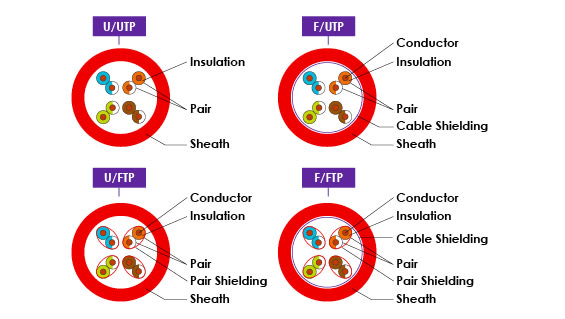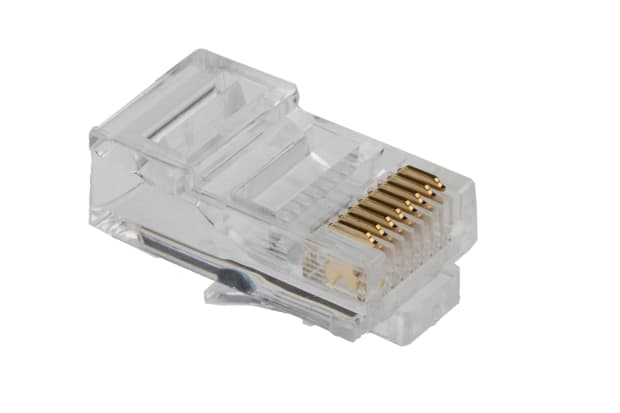- Published 30 Jan 2023
- Last Modified 29 Aug 2023
- 12 min
A Complete Guide to Cat5 & Cat5e Cable
Our Cat5 & Cat5e cable guide explains their uses, types, lengths, specifications, colours, prices, and more.

Updated April 2022
There are numerous categories of Ethernet cable sold online in the UK. When people ask, ‘what is Cat5 or Cat5e cable?’, they are usually asking what the difference is between the two, and how they relate to other widely used standards. In this guide, we will address this and other frequently asked questions about various wired internet, Ethernet, and network cable types.
We aim to provide clear and straightforward information about Cat5 and Cat5e cables. We will explain what these standards mean, give examples of their common uses, and talk about the various types, lengths, specifications, and prices.
By the end of the guide, you should have a clear understanding of Cat5 cable and Cat5e cable. You will also know about the various connectors, testers, speeds, cable lengths, and the colours associated with them, and be better placed to decide which type of Ethernet cable best suits your workplace needs.
What is Cat5 & Cat5e Cable?

Cat5 cable and Cat5e cable are common standards of network cable, typically used for Ethernet (wired internet) connectivity. Cat5 and Cat5e cables have been in widespread use since the early 2000s, but they remain among the most commonly used networking cable types today.
Cat5 & Cat5e Specification
Cat5 and Cat5e are two common classifications of Ethernet or network cabling. The Cat5e specification came into widespread use after 2001, before which Cat5 had been the latest standard.
Cat5 stands for Category 5 cable, while Cat5e stands for Category 5 Enhanced (or Enhanced Category 5). Cat5e specs offer a significant upgrade in terms of general performance and faster data transfer speeds than the earlier Cat5 versions.
However, basic Cat5 is often sufficient for those on mid-speed broadband connections, who do not need the fastest data transfer rates available.
Cat5 cable specifications dictate it should be able to handle data transfer over Ethernet networks at frequencies (also known as bandwidth, or data-carrying capacity) of up to 100 MHz. Cat5e offers superior performance and is rated for frequencies of up to 350 MHz. This is due in part to its stricter performance requirements for things like crosstalk (interference between individual wires), attenuation and return loss.
In day-to-day practical terms, most users will chiefly be interested in what internet speeds or data transfer speed each standard support.
Cat5 cable is designed to carry data over a wired network connection at speeds of 10 Mbps (Ethernet) or 100 Mbps (Fast Ethernet). You will often see this written as 10/100 Ethernet when shopping for Cat5 cable online. This means that if your local network or incoming internet connection runs at between 10-100 Mbps (also known as a 100BASE-T network), Cat5 Ethernet cable should be able to handle the required data throughput at full speed, with no loss or delay.
Cat5e cable spec dictates that it can carry data over a wired connection at speeds of either 10 Mbps, 100 Mbps, or 1000 Mbps (equal to 1 Gbps, and thus usually referred to as Gigabit Ethernet). You will often see this written as 10/100/1000 Ethernet. This means that if your local network (or incoming internet connection) runs at between 10-1000 Mbps/1 Gb (also known as a 1000BASE-T network), Cat5e Ethernet cable should be able to handle the required data throughput at full speed, with no loss or delay.
In short, for transfer speeds above 100 Mbps, or bandwidth requirements greater than 100 Mhz, you should upgrade from Cat5 to Cat5e cables or above. Note that all Cat5e cable is fully backwards compatible with any devices or ports (jacks) that support the use of a Cat5 wired Ethernet connection.
What is Cat5 & Cat5e Cable Used for?

Cat5 Ethernet cable is widely used for connecting all manner of devices on local networks. It is also commonly found supporting incoming internet or broadband connections.
- Typical uses of Cat5 cable include numerous LAN (Local Area Network) applications, such as connecting multiple computers to form a network of linked devices in reasonable proximity
- Many hubs, switches, and routers found in schools, colleges, offices, hospitals, and other workplaces will primarily be using Cat5 cable connections for the bulk of their data transfer activity
- Other standard applications include hooking up a wide range of indoor telephone, video, audio/speaker, and CCTV systems
Cat5e Ethernet cable is typically used for similar purposes but is the preferred choice for many people who need more bandwidth and faster data transfer.
This is increasingly required on more modern systems to get the best performance from high-end devices and tech setups. Many networked professional and consumer electronics devices - including high-end desktop PCs - can benefit significantly from being able to harness greater bandwidth and faster upload/download speeds. Cat5e cable is typically a more suitable choice than Cat5 for these types of demanding, high-throughput activities.
Types of Cat5 & Cat5e Cable
In basic construction terms, there are two main types of Cat5 and Cat5e cable, namely stranded core and solid core. These terms refer to how the data-carrying wires, or conductors, that make up the inner core of the cable are arranged.
Solid conductor (solid-core) Cat5/Cat5e Ethernet cable tends to be used where longer runs need to be set up to achieve a more reliable and stable permanent wired network. This is more common in office buildings and other professional setups. Applications that involve running outdoor Cat5 cable, or passing it through sections of wall, will often benefit from the use of solid-core wiring.
Stranded conductor (stranded core) Cat5/Cat5e Ethernet cable tends to be used for establishing shorter runs between temporary or easily movable wired networks. Small office networks, such as those linking computers to a router via a short Cat5e patch cable or similar will generally be fine using stranded Ethernet wiring. Most standard Ethernet patch cables at lengths of 50 feet or less will tend to have stranded conductors.
At first glance, you cannot necessarily tell whether a given length of Ethernet cable is stranded or solid without cutting through it to find out. However, stranded cable is usually a lot more flexible than solid core cable. Solid cables will often retain some degree of deflection for a while after being bent at a sharp angle.
Cat5e Cable Diagram
See to the right for a Cat5e cable diagram, showing the basic construction of different types of Cat5e Ethernet cables.
Note that they are typically manufactured as multi-twisted pair cables. They are usually constructed from four colour-coded pairs (so eight wires in total) per cable. Each pair consists of two wires twisted together to form a single strand, hence the term twisted pair wiring.

Shielded vs. Unshielded Ethernet Cable
In addition to the basic Ethernet cable standards and the stranded vs. solid designs, there are also other manufacturing specifications available for each type and category. These are commonly abbreviated as:
- U/UTP (Unshielded/Unshielded Twisted Pair): Neither the individual twisted pairs nor the cable has any additional shielding built-in. Only the basic protections - the standard insulation around each twisted wire, and the cable sheath itself - are present
- F/UTP (Foil/Unshielded Twisted Pair): While the individual twisted pairs do not have any additional shielding, the cable features an added layer of foil under the outer sheath
- U/FTP (Unshielded/Foil Twisted Pair): The individual twisted pairs each have their layer of additional foil shielding around them, but the cable only has the basic outer sheathing
- F/FTP (Foil/Foil Twisted Pair): Both the individual twisted pairs and the cable have an added layer of foil shielding around them
U/UTP is, therefore, the most susceptible to interference, signal noise, return loss, and attenuation, although the cable will be considerably cheaper to buy. F/FTP will offer the greatest protection against performance-limiting factors like crosstalk, but it will also be the most expensive type to buy.
The standard assembly for basic Cat5 cable is often U/UTP, while many high-quality Cat5e Ethernet cables are manufactured with at least some form of additional shielding built-in. This shielding helps to protect the carried signal from several forms of interference, minimising the risk of data corruption or network connection loss.
A shielded network cable is typically recommended over longer runs, for outdoor use, or where the wiring passes through walls where there is likely to be a good deal of other electrical connections nearby. An unshielded network cable is often sufficient over short indoor runs where there is less potential for crosstalk.
Cat5 & Cat5e vs. Cat6 Cable

Many people are keen to know the difference between Cat5/Cat5e and Cat6 Ethernet cable and whether Cat6 cable is compatible with Cat5-based setups.
In performance terms, Cat 6 network cable is another step up from Cat5e. It is capable of supporting data transfers at frequencies of up to 550 MHz and speeds of up to 1000 Mbps (1 Gbps, or Gigabit Ethernet). Beyond that, you can upgrade further to Cat6A (up to 550 MHz and 10 Gbps), Cat7 Ethernet cable (up to 600 MHz and 10 Gbps), and even Cat8 versions (2000 MHz and 25-40 Gbps).
Both Cat7 and Cat8 cables are only available in shielded versions, and support transfer bandwidths and speeds far more than what most office users would typically need. However, many people do choose to install Cat6 and Cat6a Ethernet cables as they offer more headroom to optimise network speeds and device performance in the future.
In terms of backward compatibility, Cat6 cable should work fine in a Cat5 or Cat5e environment, and vice versa. However, be aware that any network - wired or wireless - will tend to run at the speed of the slowest component on it, or the throughput rate of the tightest bottleneck. This should always be a consideration when deciding whether to upgrade (or indeed downgrade) your cabling.
Cat5 & Cat5e Cable Testers

A Cat5 and Cat5e cable tester is often called a network tester. They measure and test local area network (LAN) connections and can be used for troubleshooting while installing networks, checking for faults on individual cables or cores.
The role of the signal tester is to check and verify the quality of the data signal being passed from device to device via the Cat5/Cat5e cables. They do this either by sending current along the wire and checking for output level at the other end (continuity testing) or by sending both current and Voltage then checking for resistance (resistance testing).
Using a Cat5 cable tester is a good way to check that your existing cables are functioning properly and to isolate the cause of any problems.
Cat5 & Cat5e Cable Connectors

As with all Ethernet and network cables, Cat5 cables (including Cat5e) typically use the RJ45 connector standard.
RJ45 connectors look a bit like larger versions of familiar telephone wire connectors. RJ45 stands for Registered Jack #45, and it can apply to either the RJ45 plugs (male) or the RJ45 sockets (female). The plugs or modular connectors are affixed to the ends of Ethernet cables, while the sockets or jacks are normally embedded in devices or wall sockets.
Connectors for Cat5e and Cat6 network cables may be interchangeable, although it will often depend on the brand and quality of the product itself. In most cases, backward compatibility is generally quite good, but it is less common for older connectors to work optimally with newer or upgraded cabling.
One reason for this is that some high-quality Cat6 Ethernet cables achieve their higher bandwidth (and better resistance to crosstalk and attenuation) partly by using thicker individual wire strands than some older Cat5 models. In these cases, you may find that the same modular connector that fits on the end of a Cat5 cable will not be easy to rewire for the Cat6, even though the basic pinouts are the same.
Cat 5 & Cat5e Ethernet Cable: Lengths, Colours & Prices
Cat5 and Cat5e cables are available in a wide variety of different lengths. In most cases, Cat5 patch cables tend to be chosen for reasonably short runs (100ft or less), especially if they are stranded core wires.
However, there are valid use cases for choosing longer runs of Cat5e wiring, in which case you can easily buy reels in lengths of 1000ft or more. Common pre-cut lengths you will see on sale at UK suppliers include 30cm/300mm, 50cm/500mm, 1m, 2m, 3m, 5m, 10m, 30m, 100m, 152m, and 305m.
In terms of widely available Cat5 and Cat5e cable colours, the most common are usually black, grey, or white. However, it is equally easy to find Ethernet cables in a much wider variety of colours including blue, green, orange, purple, red, and yellow.
Cat5 and Cat5e cable prices vary according to brand, quality, length, and materials, as well as the type and amount of any additional shielding included in the manufacture. The cheapest Ethernet cables in this category will generally be unshielded solid Cat5 varieties, while more expensive versions will usually be stranded and shielded Cat5e leads.
You can buy cables pre-made to certain lengths and fully terminated with an RJ45 connector at either end. However, it tends to be more expensive per foot (or per metre) to buy this way. For professional systems installers, it will often work out much cheaper to buy larger drums or reels of unterminated cable. You can then cut this to the required lengths and easily wire your connectors to the pinouts.
FAQs
What is a Cat5 Crimping Tool?
A Cat5 crimping tool is a handheld, plier-like tool for crimping down a connector (usually RJ45) once it has been wired to the end of an Ethernet cable. Crimping a cable into a connector forms a reliable electrical connection between conductors and terminal and helps to prevent deterioration or insulation breakage during frequent plugging-in and removal of cables.
How Can I Tell What Type of Ethernet Cable I Have?
Most network cable has the category printed on the outer jacket for easy reference, often abbreviated as Cat5/Cat5e/Cat6 etc. If yours does not, the easiest way to tell is by using an Ethernet cable tester.
When Was Cat5e Introduced?
Cat5e was introduced in 2001 as an upgrade to the previous Cat5 standard. Cat5e has since become the more commonly used category for most office network applications, offering increased bandwidth and better resistance to various forms of electrical interference.

